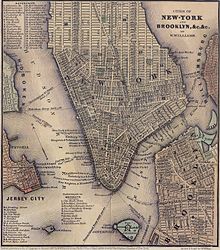Fulton Ferry (ferry)
[2] The first grant for a commercial ferry was given by Dutch governor Willem Kieft to Cornelis Dircksen in 1642; however, local waterfront land-owners were free to make their own crossings of the river.
[7] After the Revolutionary War, ferrymaster Adolph Waldron gained sole control of the ferry by virtue of being the only Whig with a claim to it.
Robert Fulton, at the behest of Brooklyn magnate Hezekiah Pierrepont, secured a 25-year lease on the ferry in 1814.
[8] Trips took no longer than twelve minutes, and there was no chance of the ship being swept upstream or downstream, or held to the whims of the wind.
[11] The shareholders of the Union Ferry Company were mostly based in Manhattan; they tended to favor increased profits over improved service.
[12] The original Fulton Ferry route continued to be successful until the 1883 opening of the Brooklyn Bridge crossing at almost the same point.
[14]: 252 With the opening of additional bridges and subway crossings of the river and the decline of animal traffic, patronage fell further.

